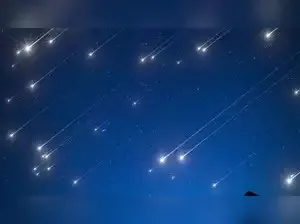Stargazers who missed the peak of the Southern Taurid meteor shower this year still have an exciting opportunity to witness the Northern Taurid meteor shower, which is set to reach its peak this week.
Known for its fireball meteors, the Taurids offer a captivating display, drawing attention with their slow, bright meteors that streak across the night sky.
When to Expect the Best View of the Northern Taurid Meteor Shower
The Northern Taurid meteor shower, active from October 13 to December 2, will be at its most visible on Monday and Tuesday, as mentioned in a report by USA Today.
While the Southern Taurid branch has already peaked, the northern branch is set to deliver its most dazzling activity during this brief window.
According to NASA, the Taurid meteors are typically visible when the constellation Taurus is positioned above the horizon, which is most noticeable between September and November.
Also Read : Netflix, Amazon Prime Video, Apple TV+, Paramount+ new shows: Check full list
Despite being less frequent than other major meteor showers like the Orionids or Perseids, the Taurid meteor streams are renowned for their larger-than-usual meteors, making them a must-watch for those seeking a spectacular display. Even though the meteors are slow-moving, they have a higher visibility, and the Northern Taurid shower promises to be particularly spectacular.
How to Best View the Northern Taurid Meteor Shower
For the best chance to see the Northern Taurids in all their fiery glory, stargazers should head outside after midnight, just before dawn.
During this time, the moon will be less of a hindrance to the viewing experience, and the sky will be darker, offering clearer visibility of the meteors.
The constellation Taurus, from which the Taurids seem to radiate, can be found by looking for the bright red star Aldebaran and the Pleiades star cluster, which forms a distinctive dipper shape in the sky, according to the USA Today report.
The Taurids are visible nearly everywhere on Earth, except for the South Pole. The American Meteorological Society notes that, unlike other meteor showers, which require telescopes or binoculars, the Taurids can be seen with the naked eye from dark, open areas.
Since meteor watching is a game of patience, astronomers recommend bringing a comfortable chair and dressing warmly, as observers may be outside for a while to catch a glimpse of these fiery streaks.
What Causes the Taurid Meteor Shower?
The Taurid meteor shower is the result of Earth's passage through the debris trail left by Comet Encke, which orbits the Sun every 3.3 years. As Earth moves through the comet's dust-filled trail, meteoroids, or space rocks, collide with the atmosphere at high speeds, burning up and creating vibrant streaks of light across the sky. These bright flashes are often referred to as "fireballs" or "shooting stars."
Both the Northern and Southern Taurid meteor showers are believed to originate from this same debris trail, which is left behind by the fragmenting Encke comet.
Also Read : Los Angeles Times owner fires the entire editorial board, gives this reason
The large debris stream is spread over a vast area of space, which is why Earth passes through it over several weeks, creating the prolonged duration of the Taurid showers.
The Northern and Southern branches are two parts of this extensive debris cloud, creating two distinct meteor showers that occur at different times of the year.
FAQs
When can I see the Taurid meteor shower?
The Southern Taurid meteor shower occurs from September 23 to November 12, peaking earlier this month. The Northern Taurids, originating from a nearby but distinct stream, are visible from October 13 to December 2, with their peak expected around November 11-12.
Which direction to look for the Taurid meteor shower?
The meteors will be visible near the Taurus constellation in the northeastern sky.
Known for its fireball meteors, the Taurids offer a captivating display, drawing attention with their slow, bright meteors that streak across the night sky.
When to Expect the Best View of the Northern Taurid Meteor Shower
The Northern Taurid meteor shower, active from October 13 to December 2, will be at its most visible on Monday and Tuesday, as mentioned in a report by USA Today.While the Southern Taurid branch has already peaked, the northern branch is set to deliver its most dazzling activity during this brief window.
According to NASA, the Taurid meteors are typically visible when the constellation Taurus is positioned above the horizon, which is most noticeable between September and November.
Also Read : Netflix, Amazon Prime Video, Apple TV+, Paramount+ new shows: Check full list
Despite being less frequent than other major meteor showers like the Orionids or Perseids, the Taurid meteor streams are renowned for their larger-than-usual meteors, making them a must-watch for those seeking a spectacular display. Even though the meteors are slow-moving, they have a higher visibility, and the Northern Taurid shower promises to be particularly spectacular.
How to Best View the Northern Taurid Meteor Shower
For the best chance to see the Northern Taurids in all their fiery glory, stargazers should head outside after midnight, just before dawn. During this time, the moon will be less of a hindrance to the viewing experience, and the sky will be darker, offering clearer visibility of the meteors.
The constellation Taurus, from which the Taurids seem to radiate, can be found by looking for the bright red star Aldebaran and the Pleiades star cluster, which forms a distinctive dipper shape in the sky, according to the USA Today report.
The Taurids are visible nearly everywhere on Earth, except for the South Pole. The American Meteorological Society notes that, unlike other meteor showers, which require telescopes or binoculars, the Taurids can be seen with the naked eye from dark, open areas.
Since meteor watching is a game of patience, astronomers recommend bringing a comfortable chair and dressing warmly, as observers may be outside for a while to catch a glimpse of these fiery streaks.
What Causes the Taurid Meteor Shower?
The Taurid meteor shower is the result of Earth's passage through the debris trail left by Comet Encke, which orbits the Sun every 3.3 years. As Earth moves through the comet's dust-filled trail, meteoroids, or space rocks, collide with the atmosphere at high speeds, burning up and creating vibrant streaks of light across the sky. These bright flashes are often referred to as "fireballs" or "shooting stars."Both the Northern and Southern Taurid meteor showers are believed to originate from this same debris trail, which is left behind by the fragmenting Encke comet.
Also Read : Los Angeles Times owner fires the entire editorial board, gives this reason
The large debris stream is spread over a vast area of space, which is why Earth passes through it over several weeks, creating the prolonged duration of the Taurid showers.
The Northern and Southern branches are two parts of this extensive debris cloud, creating two distinct meteor showers that occur at different times of the year.
FAQs
When can I see the Taurid meteor shower?The Southern Taurid meteor shower occurs from September 23 to November 12, peaking earlier this month. The Northern Taurids, originating from a nearby but distinct stream, are visible from October 13 to December 2, with their peak expected around November 11-12.
Which direction to look for the Taurid meteor shower?
The meteors will be visible near the Taurus constellation in the northeastern sky.
Disclaimer Statement: This content is authored by a 3rd party. The views expressed here are that of the respective authors/ entities and do not represent the views of Economic Times (ET). ET does not guarantee, vouch for or endorse any of its contents nor is responsible for them in any manner whatsoever. Please take all steps necessary to ascertain that any information and content provided is correct, updated, and verified. ET hereby disclaims any and all warranties, express or implied, relating to the report and any content therein.








